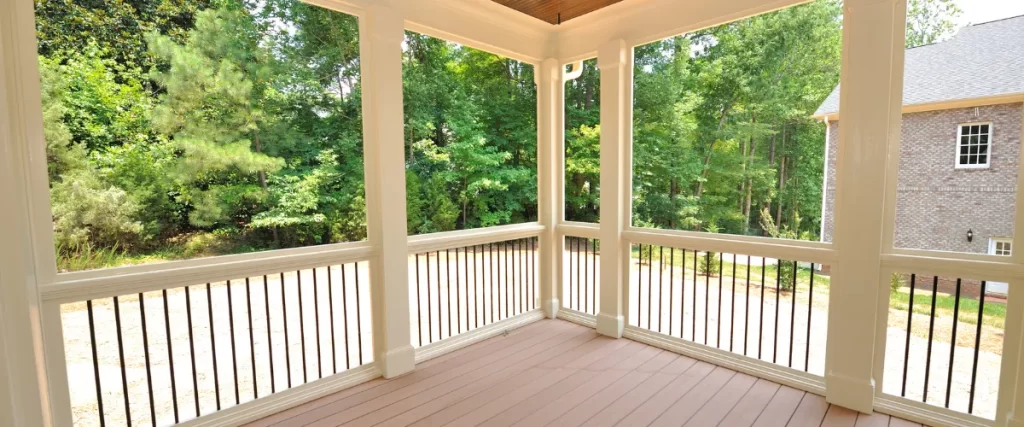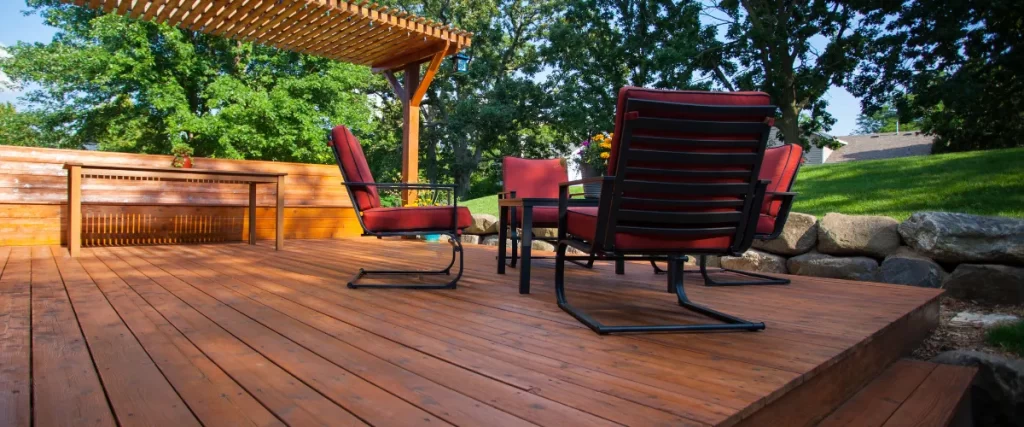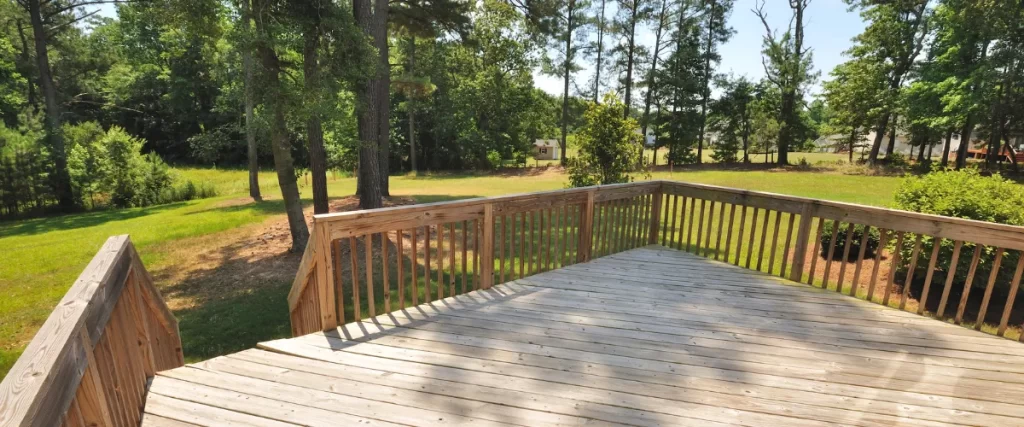When summer arrives, and the sun is shining bright, your deck becomes the perfect spot to relax. But let’s be honest—nobody wants a deck that gets so hot you can’t even walk on it barefoot. That’s why choosing heat-resistant decking materials is a smart move, especially if you live in a warm or sunny area.
In this blog, we’ll dive into some of the best heat-resistant decking options available, their benefits, and why they might be perfect for your outdoor space. Plus, we’ll cover tips for keeping your deck cool and comfortable, even during the hottest days. Let’s get started!

Why Heat Resistance Matters for Decking
Before we explore the options, let’s talk about why heat resistance is such a big deal for decking materials. A deck exposed to the sun absorbs heat, making it uncomfortable to use. Traditional wood decks, for example, can become extremely hot, leaving you looking for shoes or rugs to protect your feet.
Heat-resistant decking materials are designed to stay cooler, so you can enjoy your outdoor space without worrying about burning your toes. These materials are also less likely to warp or crack due to high temperatures, ensuring your deck lasts longer and stays looking great.
Top Heat-Resistant Decking Materials
1. Composite Decking with Cool Technology
Composite decking has become a popular choice for homeowners because it’s durable, low-maintenance, and available in a wide range of styles. Many modern composite decking brands now offer boards with heat-reflective technology. These boards are designed to stay cooler in the sun by reducing heat absorption.
Pros:
- Stays cooler than traditional composites
- Resistant to fading, warping, and splintering
- Available in various colors and textures
Cons:
- Higher upfront cost compared to wood
- Needs regular cleaning to prevent buildup
2. PVC Decking
PVC decking is another excellent heat-resistant option. Made entirely from synthetic materials, PVC is lightweight, durable, and naturally cooler than wood or standard composites. Some brands even include cooling additives in their PVC boards for extra heat resistance.
Pros:
- Superior heat resistance
- Low maintenance
- Waterproof and resistant to mold
Cons:
- Limited color options in some brands
- Can be slippery when wet
3. Aluminum Decking
If you’re looking for something truly unique and heat-resistant, aluminum decking is worth considering. Aluminum naturally reflects heat, keeping the surface cooler than most other materials. It’s also incredibly durable and weather-resistant.
Pros:
- Exceptional heat resistance
- Long-lasting and strong
- Eco-friendly and recyclable
Cons:
- Higher cost
- Industrial look may not suit all styles
4. Bamboo Composite Decking
Bamboo composite decking is an eco-friendly option that blends bamboo fibers with recycled plastic. It’s not only sustainable but also designed to resist heat better than traditional wood decking.
Pros:
- Eco-friendly and sustainable
- Heat-resistant surface
- Stylish and natural appearance
Cons:
- Requires proper sealing for durability
- Limited availability in some regions
5. Hardwood Decking
Hardwoods like Ipe, Teak, and Mahogany are naturally dense and heat-resistant. They don’t get as hot as some other wood types, making them a great option for a classic, natural-looking deck.
Pros:
- Beautiful, natural appearance
- Heat-resistant compared to softer woods
- Long-lasting with proper maintenance
Cons:
- High upfront cost
- Regular maintenance needed to prevent weathering
Tips for Keeping Your Deck Cool
Even if you choose a heat-resistant decking material, there are additional steps you can take to ensure your outdoor space stays comfortable on hot days:
- Add Shade: Install a pergola, umbrella, or canopy to block direct sunlight.
- Choose Lighter Colors: Light-colored decking reflects more heat than darker shades, keeping the surface cooler.
- Install Outdoor Rugs: Heat-resistant outdoor rugs can provide a comfortable surface for walking.
- Use Misting Systems: A misting system can help cool down the area and create a refreshing atmosphere.
- Plan Strategic Landscaping: Plant trees or tall shrubs to provide natural shade around your deck.
Choosing the Right Heat-Resistant Decking for Your Home
When deciding on the best heat-resistant decking material, consider your budget, style preferences, and how you plan to use the space. For example:
- For families with kids or pets: Opt for a material like PVC or composite with cooling technology to ensure everyone can enjoy the deck safely.
- For eco-conscious homeowners: Bamboo composite or aluminum decking offers sustainable and heat-resistant solutions.
- For those seeking luxury: Hardwood decking adds a timeless and elegant touch while staying relatively cool in the sun.
If you’re unsure which material is best for your needs, a professional deck installer can help guide you through the options.

More Benefits of Heat-Resistant Decking Options
When you invest in heat-resistant decking, you’re not just making your deck more comfortable—you’re also adding long-term value and functionality to your home. Let’s explore some additional benefits of these innovative materials to help you decide which option is best for your outdoor space.
1. Enhanced Safety for Families and Pets
One of the biggest advantages of heat-resistant decking is the safety it provides for your loved ones. A deck that stays cooler in the sun means fewer chances of burns or discomfort when walking barefoot, especially for small children and pets who love playing outdoors. It’s a practical and thoughtful way to make your backyard more family-friendly.
2. Longevity and Durability
Heat-resistant decking materials are often designed to withstand not just heat but other harsh weather conditions as well. Materials like composite and aluminum are resistant to warping, cracking, and fading caused by prolonged exposure to sunlight. This means you’ll enjoy a beautiful, sturdy deck for many years without needing frequent repairs or replacements.
3. Low Maintenance Equals Less Hassle
Most heat-resistant decking materials require minimal upkeep. Unlike traditional wood, which needs regular staining, sealing, and sanding to prevent damage, options like PVC and composite are incredibly easy to maintain. A simple sweep and occasional rinse are all you need to keep your deck looking brand-new, leaving you with more time to relax and enjoy it.
4. Cooler Gatherings and Events
If you love hosting gatherings or barbecues, a heat-resistant deck makes your space much more inviting. Nobody wants to sit on or walk across a deck that feels like a stovetop! With a cooler surface underfoot, you can create a comfortable environment where everyone can relax and have fun.
5. Environmentally Friendly Choices
Many heat-resistant decking materials, such as bamboo composites or recycled PVC, are eco-friendly options that reduce your carbon footprint. These materials make it easier to create a sustainable outdoor space without compromising on style or comfort.
Customizing Your Heat-Resistant Deck
Once you’ve selected the perfect heat-resistant material, it’s time to think about the design and features that will make your deck truly yours. Here are some ideas to take your outdoor space to the next level:
- Built-in Seating: Add benches or seating areas directly into your deck design for convenience and style.
- Outdoor Kitchen: If you love entertaining, consider incorporating a grill, countertops, or even a small sink into your deck setup.
- Lighting: String lights or recessed deck lights not only improve safety but also create a cozy atmosphere for evening gatherings.
- Privacy Screens: Use lattice panels, tall plants, or decorative screens to make your deck feel more intimate and secluded.
- Cooling Features: Add a retractable awning, shade sail, or pergola to keep the area even cooler on the hottest days.
Maintenance Tips for Heat-Resistant Decks
To keep your heat-resistant deck in top shape, follow these simple maintenance tips:
- Regular Cleaning: Sweep your deck regularly to remove dirt and debris. Wash it with mild soap and water every few months.
- Inspect for Damage: Check for cracks, loose boards, or other issues that may need repair.
- Protective Coating: Apply a UV-resistant sealant or coating to enhance the heat resistance of your deck.
- Seasonal Prep: Before summer, clean and inspect your deck to ensure it’s ready for the heat.
FAQs About Heat-Resistant Decking
Q: Is composite decking cooler than wood?
A: Modern composite decking with cooling technology is often cooler than wood, especially in lighter colors. However, traditional composite can get quite warm under direct sunlight.
Q: Can I install heat-resistant decking on my own?
A: While some DIY enthusiasts may feel confident installing decking, hiring a professional ensures the job is done correctly and safely.
Q: Which decking material stays the coolest?
A: Aluminum decking tends to stay the coolest due to its natural heat-reflective properties.
Q: Are heat-resistant decks more expensive?
A: Heat-resistant materials like composite with cooling tech or aluminum decking often have higher upfront costs but save money in the long run due to durability and low maintenance.

Transform Your Deck with Deck Bros
Ready to beat the heat and upgrade your outdoor space? At Deck Bros, we specialize in designing and installing heat-resistant decks that are perfect for summer relaxation.
Whether you prefer the look of composite, PVC, or hardwood, we’ll help you choose the best material for your needs and bring your vision to life. Contact Deck Bros today for a free consultation at (402) 369-5724, and let’s kickstart your deck building project!
